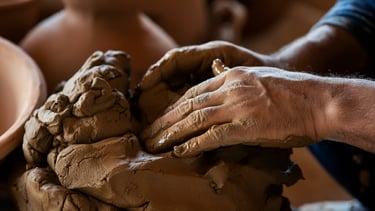Stages and Methods of Making Moroccan Pottery
CRAFTSMANSHIP & TECHNIQUES


Moroccan pottery epitomizes the nation's artisanal legacy, with origins firmly rooted in centuries-old traditions. The manufacturing process, which includes clay preparation, shaping, drying, embellishment, and fire, exemplifies Moroccan craftsmen's expertise. Every phase is a meticulous undertaking that underscores the relationship between artistry and the natural world. Nevertheless, while several aspects of Moroccan pottery are sustainable, some processes pose environmental challenges. This article examines the essential phases in the creation of Moroccan pottery, the ecological consequences of each stage, and how contemporary artists are reconciling tradition with sustainability.
Clay preparation is the foundation of Moroccan pottery.
The first phase of pottery production is clay preparation, which begins with the acquisition of natural clay. Moroccan potters have always used locally obtained clay, a process that is sustainable in several aspects. Artisans use localized resources to reduce transportation emissions and boost local economies, thereby maintaining the craft's connection to the community. Next, they immerse the clay in water, filter it to remove impurities, and knead it to achieve the right consistency for molding.
This technique is mostly sustainable, yet a significant environmental issue arises in water use. Morocco has increasing water constraints, and the processes of washing and soaking clay require a significant amount of water. In areas with few water resources, potters are under pressure to use water-efficient techniques. Some have started the practice of recycling water inside their workshops, repurposing the same water for many batches of clay preparation. This method conserves water and diminishes the total environmental impact of the manufacturing process.
Forming the Pottery: An Art of Skill and Sustainability
After preparing the clay, potters either manually mold it or use a potter's wheel. During this phase, the artisan's expertise is evident as they meticulously shape each piece to achieve its desired form. The use of handcrafting processes guarantees that each piece is distinctive, reflecting the personal touch of the artist. This process is intrinsically sustainable in contrast to the mass-produced pottery prevalent in industrial environments, which often depends on technology and extensive resource use.
The worldwide demand for Moroccan ceramics is increasing, especially as the craft gains recognition in foreign markets. Consequently, craftsmen are under heightened pressure to augment productivity. The difficulty is in preserving the authenticity of traditional handcrafting techniques while accommodating increased production requirements. To attain this equilibrium, several craftsmen are investigating sustainable manufacturing methods, including the use of renewable energy to operate their workshops and the adoption of energy-efficient instruments that enhance traditional artistry.
Drying: An Organic and Sustainable Procedure
After shaping, we must completely dry the pottery before firing. The drying phase is essential as it mitigates cracking and guarantees the structural integrity of the artwork. Moroccan potters typically air-dry their creations, depending on the natural atmosphere, to gradually remove moisture from the clay. This process is both effective and completely sustainable since it needs no further energy supplies.
Nevertheless, heightened demand presents the allure to expedite the drying procedure. Potters may use artificial heat sources to expedite drying time, especially during peak production seasons. This strategy may enhance efficiency, but it simultaneously elevates energy consumption, undermining the environmental advantages of natural drying techniques. It is important to motivate craftspeople to adhere to traditional drying methods, despite significant demand, to ensure sustainability. Alternatively, potters may investigate passive solar drying methods, which use sunlight in a regulated setting to expedite the process without using extra energy.
Decoration: Maintaining Authenticity with Natural Pigments
The exquisite hand-painted motifs are among the most identifiable features of Moroccan ceramics. Natural paints, such as cobalt blue, ochre, and many earthy shades sourced from minerals and flora, often create vivid hues and intricate designs. This dependence on natural resources improves Moroccan ceramics' sustainability and embodies the craft's cultural and artistic legacy.
Nevertheless, as international preferences change, several potters have transitioned to synthetic paints and glazes to satisfy the need for contemporary designs and finishes. Although these materials provide a broader spectrum of colors and effects, they also provide considerable environmental hazards. Synthetic paints and glazes frequently contain harmful chemicals that can seep into the environment during manufacturing and after disposal. Furthermore, they undermine the authenticity of Moroccan pottery, which has always been esteemed for its inherent beauty.
In response to these issues, several craftspeople are reverting to natural colors and non-toxic glazes. This transition not only safeguards the environment but also bolsters the cultural authenticity of Moroccan ceramics. Organizations and projects that advocate for sustainable pottery manufacturing often provide training and tools to assist craftsmen in this transition, guaranteeing that the craft stays aesthetically pleasing and environmentally viable.
Firing: Mitigating the Environmental Impact of Kilns
Fire, the final step in Moroccan pottery fabrication, involves subjecting the items to heat in a kiln to solidify and fortify the clay. The firing process is perhaps the most energy-intensive aspect, and historically, Moroccan potters have used wood-fired kilns. These kilns provide a unique polish to ceramics, although they also exacerbate environmental damage. Using wood as fuel can lead to deforestation, particularly when the extraction process is not sustainable. Furthermore, the combustion of wood releases significant quantities of carbon dioxide and other contaminants into the environment.
To alleviate these environmental effects, potters are investigating more sustainable kiln processes. Some potters are switching to electric kilns, powered by sustainable energy sources such as solar or wind. Solar-powered kilns are becoming popular in Morocco, where enough sunshine offers a feasible substitute for conventional wood-fired techniques. These kilns not only minimize carbon emissions but also provide a more uniform fire process, resulting in superior-quality pottery.
In addition to modern kiln technology, potters can reduce their environmental footprint by using energy-efficient fire methods. Some artists use batch firing methods, allowing for the simultaneous burning of multiple items while reducing fuel consumption per item. Others are exploring low-temperature firing techniques that decrease energy use while maintaining the pottery's durability and aesthetic quality.
Achieving Equilibrium: Tradition Confronts Sustainability
The creation of Moroccan pottery is a multifaceted process that embodies the profound relationship between artists and the environment. Every phase, from clay preparation to firing, is grounded in history while still offering avenues for modernity in response to environmental issues. The craft incorporates several ecological practices, including the use of natural resources and artisanal processes, although the increasing demand for Moroccan pottery underscores the want for more innovation.
By using more sustainable practices—such as recycling water, utilizing natural pigments, or shifting to energy-efficient kilns—Moroccan potters may preserve their success while reducing their ecological impact. The difficulty is to reconcile the preservation of cultural heritage with the use of contemporary technologies that enhance sustainability. By doing so, Moroccan pottery will continue to be an essential component of the nation's creative identity while also fostering a more sustainable future.
Summary
The production of Moroccan pottery exemplifies the country's profound artisanal legacy, with each phase of the process embodying centuries-old traditions. The craft is fundamentally sustainable, especially due to the use of natural resources and artisanal skills; yet, it faces environmental difficulties that need attention. With the increasing worldwide demand for Moroccan ceramics, artists must scale production while maintaining sustainability. Moroccan potters may persist in producing aesthetically pleasing, utilitarian, and environmentally sustainable artworks by using new methods and technology, such as water recycling, natural pigments, and solar-powered kilns. These measures will ensure the craft maintains its traditional relevance while also promoting a more sustainable future.
